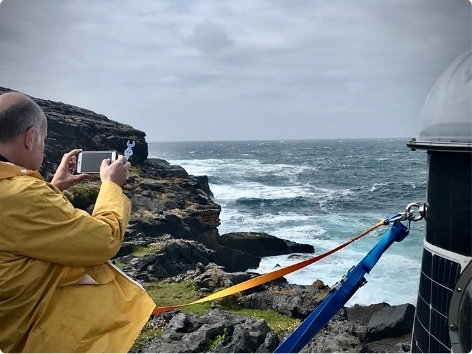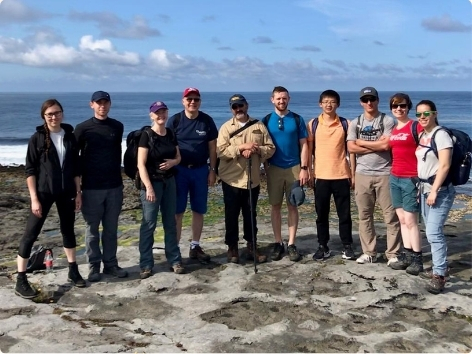Breaking waves: science in the Aran Islands

Frédéric Dias integrated local expertise from Ireland’s Aran Islands into ocean wave research, advancing science and strengthening community resilience.
‘As part of the HIGHWAVE project, we built a research station on the Aran Islands to observe the breaking of ocean waves. Public engagement was key from the start, including in selecting the station’s location. Before the project officially began in 2019, we held public meetings on all three islands - Inis Mór, Inis Meáin, and Inis Oírr - where residents could review our plans and share their views. At the Inis Meáin meeting, 10 per cent of the island’s population attended.’ One of the most striking questions raised at these meetings shaped the project’s entire public engagement strategy: ‘What will happen when the project finishes? Will you dismantle the research station? Will this be just another research project that doesn’t really benefit the local community?’ Dias and his team took this concern to heart. ‘From that moment on, everything we did was with the goal of keeping the research station alive beyond the project’s end.’
One of the most striking questions raised at these meetings shaped the project’s entire public engagement strategy: ‘What will happen when the project finishes? Will you dismantle the research station? Will this be just another research project that doesn’t really benefit the local community?’ Dias and his team took this concern to heart. ‘From that moment on, everything we did was with the goal of keeping the research station alive beyond the project’s end.’
Building trust and long-term relationships with the islanders became central to the project. ‘Face-to-face interactions with the local community happen daily. We’ve been visiting Inis Meáin continuously for over four years. We also hired Pat, a local fisherman, to work with us, which not only helped with knowledge transfer but also strengthened communication with Irish-speaking residents. With fewer than 200 year-round inhabitants, everyone on Inis Meáin knows about HIGHWAVE.
Hiring Pat, a local fisherman, not only helped with knowledge transfer but also strengthened communication with Irish-speaking residents
 In 2022, the team took their outreach a step further by organising the first Aran Islands Research Station International Conference. The event was intended to be hybrid, but an incoming storm stranded the on-site participants on the island while their colleagues gathered at the University of Galway instead. Dias: ‘This experience further strengthened the links between our project and the local community. As the school director told our participants: Now you understand even better what it means to live on a remote island in a harsh environment.’
In 2022, the team took their outreach a step further by organising the first Aran Islands Research Station International Conference. The event was intended to be hybrid, but an incoming storm stranded the on-site participants on the island while their colleagues gathered at the University of Galway instead. Dias: ‘This experience further strengthened the links between our project and the local community. As the school director told our participants: Now you understand even better what it means to live on a remote island in a harsh environment.’
The project also forged strong ties with the local school, says Dias. ‘Students regularly visit the station to follow its progress. A memorable moment came when our weather station detected the pressure wave from the 2022 Hunga Tonga–Hunga Haʻapai eruption—more than 16 000 km away. The students suddenly grasped how climate must be understood on a global scale. It was an eye-opener. Some of them even developed science projects based on our research, winning prizes at national competitions, including the BT Young Scientist Exhibition in 2022, 2023 2024, and 2025.’
Beyond scientific exchange, the local community played an active role in supporting the research. Fishermen provided boat transport, and access to the island’s airport was granted for drone deployment. When storms hit, locals ensure the team’s equipment is safe.
Sometimes, explaining our work in simple terms to schoolchildren can have more impact than a scientific paper
The impact of this engagement has been profound, not only for the community but also for the researchers, says Dias. ’As one PhD student reflected: 'In HIGHWAVE, public engagement became one of the most important aspects for me. If what I do as a scientist is not clearly communicated to the public, the value of my research drops significantly. I have realised the importance of integrating local communities into scientific research. Sometimes, explaining our work in simple terms to schoolchildren can have more impact than a scientific paper. Moving forward, I will make public engagement a top priority in my career—ensuring my research is accessible, using the right language for different audiences, and listening to the knowledge the public can share.' It’s not just about scientists telling the world what we do. Sometimes, we need to go out and listen.’


Biography
Frédéric Dias is a professor at the School of Mathematics and Statistics at University College Dublin, Ireland. He is also a principal investigator at MaREI, the SFI Research Centre for Marine and Renewable Energy, and holds a position at Ecole Normale Supérieure Paris-Saclay, France. He has been awarded two ERC Advanced Grants - MULTIWAVE, which investigated extreme and rogue wave phenomena, and the ongoing HIGHWAVE project, which studies the physical mechanisms behind destructive breaking waves on the ocean’s surface. He also received two ERC Proof of Concept Grant, including REALTIMESEA, which aims to develop technology for real-time wave measurement.





